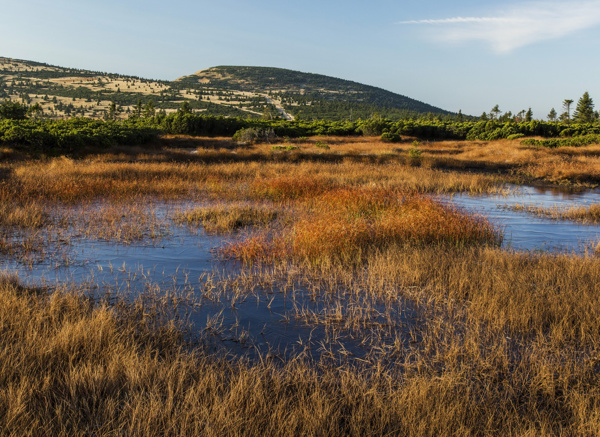There is an increased risk of spontaneous fall of branches and trees throughout the National Park, where the laws of nature govern the formation and termination of trees. Enter the forest at your own risk!
Peat bogs are the youngest landforms, which began to develop after the end of the Ice Age, during the last 10 to 15 thousand years, especially on the plateaus of the western and eastern Krkonoše Mountains, water from rainfall and melting snow accumulated in the flat lowlands with poorly permeable subsoil, which encouraged the massive development of wetland vegetation, especially peat mosses, sedges, deergrass, and rushes. Poor decomposition and accumulation of their dead bodies led to the formation of peat organic matter.

There are approximately 60 peat bogs in the Krkonoše Mountains with an area of more than 0.5 ha and a peat depth of more than 0.3 m (total area of 268 ha). The most famous are the Úpa Peat Bog, situated on both sides of the state border near Luční bouda, the peat bogs on Bílá louka Meadow and Čertova louka Meadow and Stříbrný hřbet Ridge, and the Pančava Peat Bog in western Krkonoše. The Úpa and Pancava peat bogs were included in 1993 among the areas of the so-called Ramsar Convention, which includes the most important wetlands in the world. They are the home of glacial relics (plants include the cloudberry, Sudetic lousewort, Lindberg bog moss, wildlife includes the wetland vole, dragonflies, the alpine emerald and the azure hawker, and the wolf spider Arctosa alpigena lamperti). Other notable plant species include the small cranberry, marsh andromeda, crowberry Empetrum hermaphroditum, hare´s-tail cottongrass and the common cotton grass, deer grass, bottle sedge, mud sedge and few-flowered sedge and a rich gallery of peat mosses. Among the notable species of insects are the diving beetle Hydroporus nivalis, the ground beetle Patrobus assimilis, the already mentioned dragonflies, the caddisflies Oligotrichia striata, the dwarf spider Bolyphanthes luteolus, the brindled ochre, from the bird life the common redpoll, the bluethroat, the dunnock.